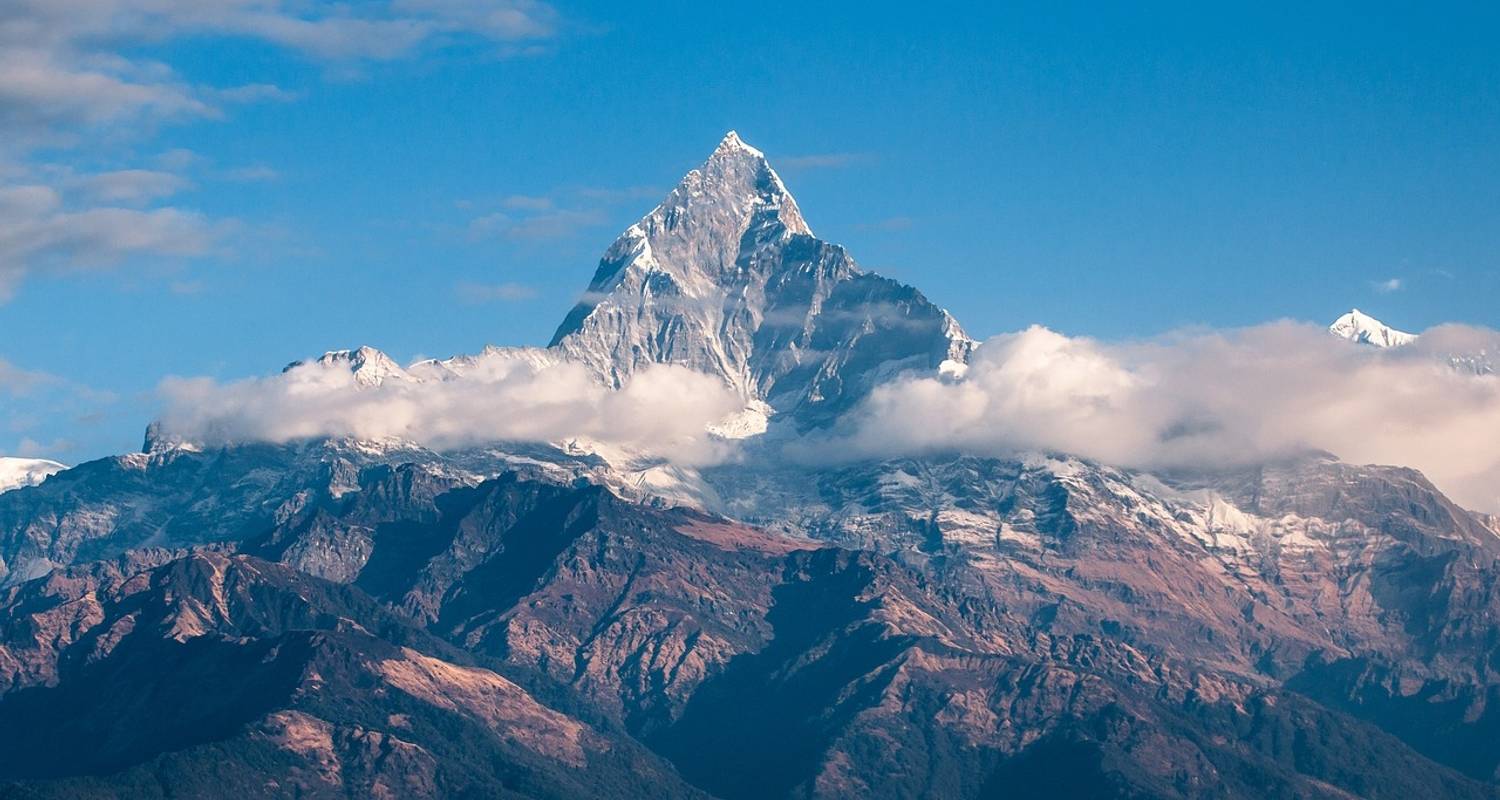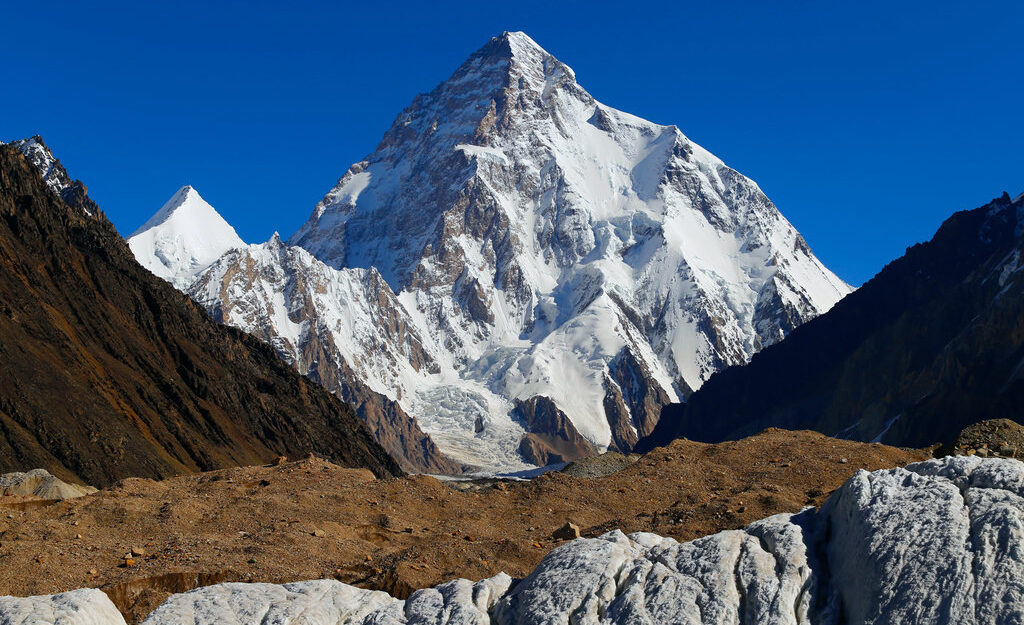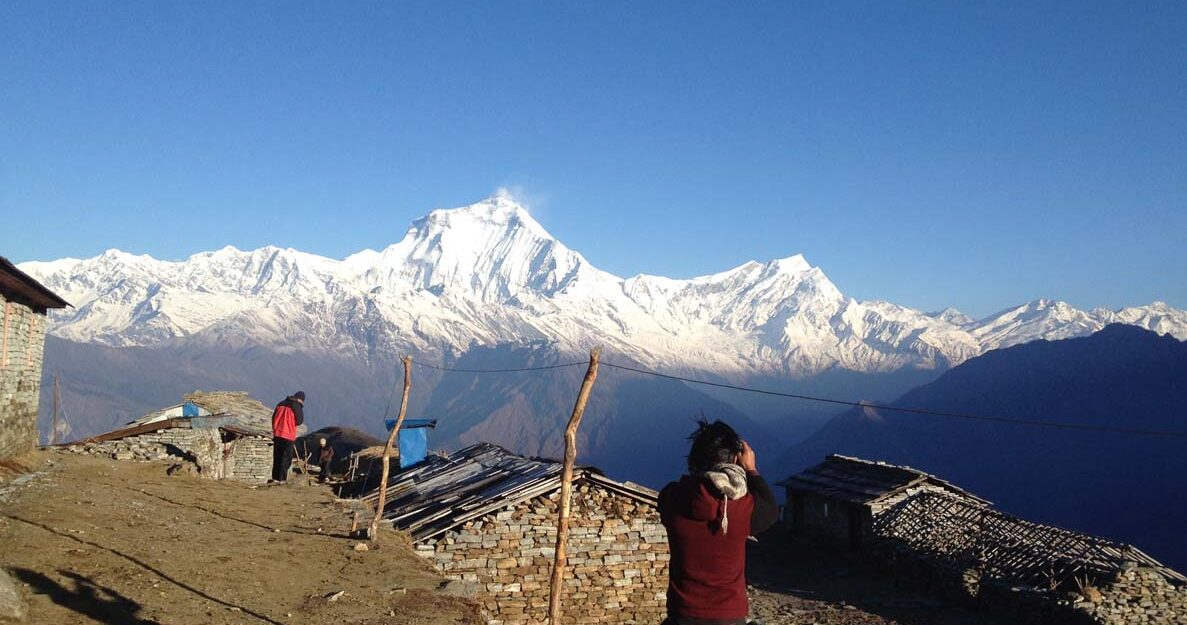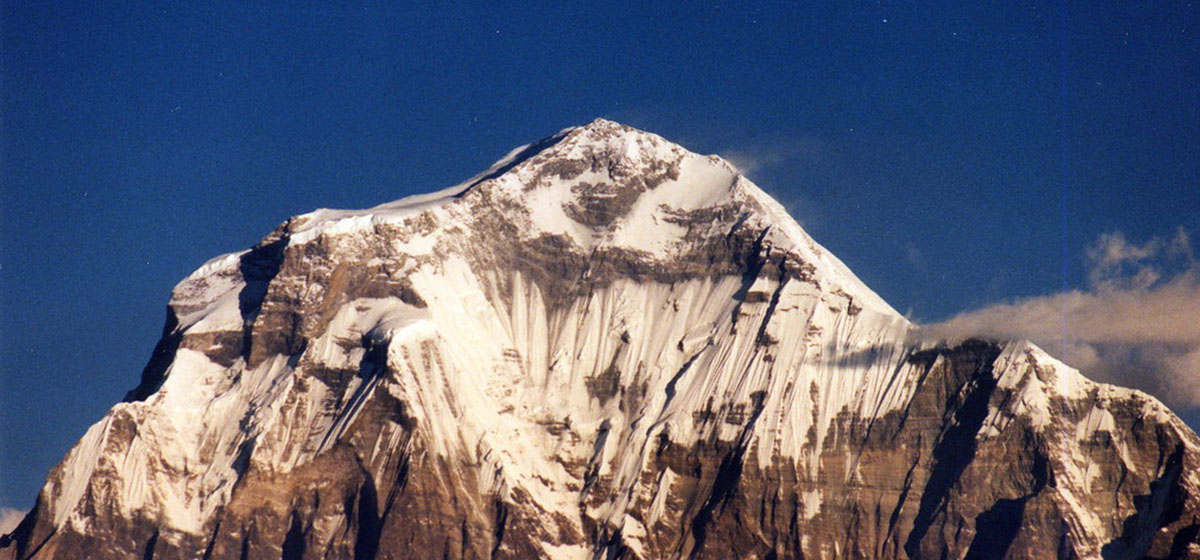
Dhaulagiri Circuit Trek Difficulty
All trekkers from all around the world enjoy the incredible experience of climbing one of the seventh highest peaks above 8000 meters. The Dhaulagiri Circuit Trek travels across the lateral moraine, freezing glaciers, and numerous snow-covered hills. You have a fantastic opportunity with this journey to complete a circuit of the Nepali Himalayas. Likewise, in this article, we will discuss the Dhaulagiri Circuit Trek Difficulties.
The peak is referred to in Nepal by its Sanskrit name, Dhaulagiri. Giri means mountain, while Dhaula means brilliant, white, and lovely. From the Kaligandaki River in the west to the Bheri, the Dhaulagiri massif stretches over 120 kilometers. One of the difficult yet thrilling experiences is the circuit walk to the world’s seventh-highest mountain, which is 8,167 meters above sea level. Dhaulagiri was first scaled on May 13, 1960, by a Swiss/Austrian/Nepali expedition. It is located inside the boundaries of the nation of Nepal. The strenuous yet thrilling climb leads hikers to the foot of Mount Dhaulagiri, the seventh-highest peak in the world, in the Annapurna Region (8167m).

Dhaulagiri Circuit Trek
The main draws of this circuit walk are the breathtaking views of the spectacular Dhaulagiri massif and other mountain peaks that are higher than 7000 meters. For those seeking an expedition-like experience, the Circuit trip is difficult and a true adventure. On the journey, one may also take in the farming communities in the foothills of the Himalayas, high alpine pastures, deserted valleys, and up-close views of numerous peaks over 8,000 meters.
Dhaulagiri Circuit Trek is one of the difficult excursions among a number of circuit treks in the Himalayas in Nepal. Your arrival at Kathmandu’s Tribhuvan International Airport marks the start of the journey. Fly to Pokhara, another popular tourist destination in Nepal, from Kathmandu next. Drive to Darbang from Pokhara. From here, the true trip begins. Similar pathways through heavily forested areas and terraced high terrain will be encountered.
Additionally, the trekkers will have the chance to pass by a number of Magar communities, giving them an understanding of their culture and way of life. You can travel through three base camps on the circuit hike, including the Italian Base Camp, Dhaulagiri Base Camp, and Japanese Base Camp.
The breathtaking icefall that descends from the northeast col between Dhaulagiri and Tukuche Peak will captivate travelers. Moreover, if you don’t carry essential equipment with you during the trip then it might add to the Dhaulagiri Circuit Trek Difficulties.

On the other hand, hikers carefully ascend to the French pass while moving over a white, ice path across glacial moraines. With a height of 5360m, it is the trek’s highest point. The trail then continues to the Hidden Valley, which is located behind the Dhaulagiri massif. The hikers arrive at Jomsom after passing across the Dhampus Pass and Thapa Pass. Therefore, for those who want challenges, this hike includes traversing a high mountain pass and walking over creaking glaciers.
Highlights of Dhaulagiri Circuit Trek
- Visit Fewa Lake, David Falls, Mahendra Cave, Seti George, and other attractions in the Pokhara Valley.
- Examining the Kali Gandaki Gorge, which runs between Annapurna I and Dhaulagiri I and is the deepest in the world.
- A close-up image of Dhaulagiri with a 360-degree panorama of famous peaks above 8,000 m, including Mount Machhapuchhare, Mount Annapurna, Mount Manaslu, and many others.
- Experiencing a cracking glacial trek and traveling across high passes such as the Thapa pass and French pass (5,365 m) (5,244 m)
- chance to examine distinctive cultures and customs alongside the complex way of life of people and groups
- A mind-blowing sensation is created by taking a dip in natural hot spring water.
- Take a trek that is entirely camping or home-stay-based.
Facts of Dhaulagiri Circuit Trek
- The Dhaulagiri mountain range includes the seventh-highest mountain in the world, Dhaulagiri, which is located in Nepal.
- Its name is Sanskrit in origin and means “white beautiful mountain.”
- After being successfully scaled for the first time in 1960, Dhauligiri has since been done so hundreds of times.
- Between 1950 and 1959, climbers from Switzerland, France, Argentina, and Austria made several efforts to reach the peak of Dhaulagiri. Out of which every attempt made via the mountain’s north side was unsuccessful.
- Using the northeastern approach, a Swiss-Austrian team under the direction of Max Eiselin accomplished the first successful climb.
- When Dhaulagiri was discovered in 1808, Mount Chimborazo in Ecuador was no longer considered to be the tallest mountain in the world.
- Two 8000m (26,250ft) summits surround Dhaulagiri, which dominates the vast Kali Gandaki Valley, which according to some estimations is the world’s deepest valley (Dhaulagiri I & Annapurna I).
How Difficult is Dhaulagiri Circuit Trek?
The journey has a reputation for being among Nepal’s toughest hikes. It demands physical stamina, trekkers in excellent health, and prior trekking experience due to its demanding level. However, the daily trekking distance of 5 to 6 hours is difficult enough for even seasoned hikers. The actual route is challenging because it includes numerous ascents and descents throughout the day.
The walk also passes through a number of lovely communities at low altitudes, but at higher altitudes, the trails become limited and the steep slopes are challenging. Because it is a camping hike, a knowledgeable trekking guide and a strong porter to carry camping gear are essential. Every step of the trail will be assisted by the guide and porter.
Additionally, they can assist with meal preparation and fix the camping tent to block the wind. This trek’s altitude rises swiftly because it only takes 4–5 days to reach elevations beyond 4000 meters. Therefore, if you are not careful enough then it might add to your Dhaulagiri Circuit Trek Difficulties.
At Darbang village, which is at a low altitude of 1,180 meters, the first few days will be extremely hot and humid, with temperatures reaching up to 25 to 30 degrees Celsius. Trekking can therefore be extremely taxing on hot, muggy days. Carry a bandana, scarf, or hat with a broad brim, as well as high SPF lip balm and sunscreen.
Trail
The trail will follow a small valley from Muri village to Myagdi Khola. The trail is very challenging because it is high up and exposed, with a sharp drop to the river below.
The path through the woodland above Boghara camp contains many exposed tree roots. Through the route, it is simple to trip or slip.
From Italian Base Camp, descend a steep glacial moraine to reach the glacier before returning up the opposite slope. A route has been made out of the fixed rope that was there previously. There is a hill with a winding trail and a sharp plunge down to the glacier below on the other side of the glacier.
A significant chance of rockfall exists while visiting Chonbarden Gorge. Camping is therefore not an option here. We also require everyone to wear a helmet while walking.
The river crossing can even be difficult in some locations.
Despite occasionally having a high slope covered in deep snow, the French pass’ descent is not very difficult.
Compared to French Pass, where the ascent is simple, Dhampus Pass requires more effort to cross. However, the drop is barely 100 meters long. Similar to that, there is a four-hour trip over a contouring path. Despite the slope’s constant 30-degree angle, the track is not overly exposed. Here, there is a significant chance of slipping or falling in snowy or icy weather.
Hidden Valley is a chilly location at a height of 5050 meters. The nightly low can reach about -15 degrees Celsius.
Altitude Sickness in Dhaulagiri Circuit Trek
One of the biggest challenges of a high-altitude journey like the Dhaulagiri Circuit Trek is altitude sickness. It happens as a result of the quick ascent to greater elevations of over 500–1000 m or more. The atmospheric pressure thins and the oxygen content declines as you ascend higher. Your body is abruptly exposed to new environments that it was not accustomed to.
Your breathing may become difficult as a result. The main cause of altitude sickness is an inadequate acclimatization process. No one has to experience altitude sickness while on a high-altitude journey. Anybody can experience it, regardless of their age. Therefore, if you are not careful enough then it might add to your Dhaulagiri Circuit Trek Difficulties.
Altitude sickness symptoms might begin to appear as low as 2500 meters and higher. Additionally, the Dhaulagiri circuit walk has a higher height at 5360m. Thus, common symptoms like headaches and fatigue are frequently seen. However, you might need to end the trip if the symptoms get worse.
Altitude sickness can occasionally strike even physically fit and healthy people. Simply put, your body is unable to adapt to the new environment’s lower air quality. You might have issues like nausea, headaches, loss of appetite, and, most frequently, fainting. You can be ready to take medication, but you should try to avoid it naturally first. Drink a lot of water, go for a slow stroll if you’re tired, and pay attention to your body. Don’t push your body or rush for it.
Acute Mountain Sickness
When trekking to high altitudes, it is the most prevalent type of sickness. Acute Mountain sickness is particularly dangerous in environments where breathing is difficult. Additionally, high-altitude pulmonary edema, a more deadly form of altitude sickness, causes fluid to accumulate in the lungs and makes breathing difficult. Therefore, if you are not careful enough then it might add to your Dhaulagiri Circuit Trek Difficulties. This often occurs after two nights spent at a high altitude, but it can occasionally occur sooner or later.
High Altitude Pulmonary Edema
This takes place pretty fast. It has an immediate impact on the respiratory system, which can make people pass out or even result in death. People typically experience no pain in this situation. They overdo the trek by pushing themselves too hard. Unaware, it could have an impact on their physique. So, if you are not careful enough then it might add to your Dhaulagiri Circuit Trek Difficulties. This is a very deadly type of illness where patients can pass away as they sleep. Therefore, with this form of illness, one needs to exercise extra caution, try to stay hydrated, and avoid overexerting one’s body.
High Altitude Cerebral Edema
High altitude cerebral edema, the most severe type of altitude sickness, is when fluid accumulates in the brain. The person experiences severe headaches and negative mental state changes as a result of the fluid swelling in the brain. The group should move downstairs as soon as possible since someone in the group has a terrible headache. The person will get uncoordinated and eventually cause death if they remain at the same altitude. We must exercise caution in the initial phase and employ diamonds as a line of defense to avoid this stage.

Dhaulagiri Circuit Trek Difficulty
Route Difficulty
In comparison to other trekking locations, the Dhaulagiri Circuit Trip Route is rated as a moderate to difficult level trek. It will be challenging to trek across rural areas and populated villages. Both novices and experienced climbers may find the routes difficult. There will be numerous difficult ascents and descents during this excursion. Additionally, even for seasoned walkers, spending 6 to 7 hours a day on unusual trails might be challenging.
Altitude sickness
The altitude of the Dhaulagiri Circuit hike is another significant challenge. A completely higher level altitude for anyone who is unfamiliar to the area, 5360m, is reached throughout the circular trek. Since the symptoms of altitude sickness begin anywhere over 2500 meters. Therefore, an increase in altitude can cause weariness and shortness of breath in anyone. The body needs hours to acclimate to its new temperature since the level of oxygen drops as the temperature rises. This could result in issues like altitude sickness. Therefore, if you are not careful enough then it might add to your Dhaulagiri Circuit Trek Difficulties.
Weather Conditions
One of the important factors to take into account when going on a hike is the weather. Yin altitude can be made simpler and more effective by the lovely clear and sparkling weather. However, it is impossible to forecast the weather at altitude. In the course of a day, the climate in the alpine region undergoes numerous changes. One moment it may be sunny, and the next it may be windy. In addition, the winter and monsoon seasons are when the weather is most erratic. Similar to this, there is a strong likelihood of traffic blockades because of intense rain and snowfall. Additionally, inclement weather may cause delays or even the cancellation of the expedition. As a result, while hiking during these seasons, you need to be well-prepared.
Best Season for Dhaulagiri Circuit Trek
The popularity of trekking in Nepal extends to both the hilly terrain and the Himalayas. Since Nepal is a Himalayan country, there are many different places to go on a trek or vacation. The Dhaulagiri circuit trek is another difficult trek that leads to an expensive trip to the Himalayas. Planning the trek is crucial, especially for a challenging climb like the Dhaulagiri circuit trek.
Additionally, the duration of the expedition is planned here. The entire year can be spent trekking in Nepal. However, the ideal time will vary depending on where you plan to hike. There are four distinct seasons in Nepal: spring, monsoon, autumn, and winter.
The best times of year to trek in the Himalayas are in the spring and fall. The same is true of the walk around Dhauligiri. With some additional planning and safety measures, you can hike through the winter and monsoon.
Spring Season
The spring season in Nepal lasts from March through May. These mark the start of new growth everywhere in the area. In the spring, the valley will be more verdant and the woodland walk will be covered in flower buds. Along the route, hikers and tourists can take in the natural vegetation. With a brilliant blue sky and an amazing view of the mountain summit, the weather and temperature are also ideal for the trek.
Even though it’s chilly there, the days are warm, making it comfortable for a walk or excursion. The nights are also not too hot or too cold. However, it can get a little chilly in the mornings. Consider going on a trek in the spring if you are wholly into the natural world. The beauty of nature is on display in spring.
Monsoon Season
The monsoon season in Nepal lasts from June through August. The monsoon season, which begins as soon as spring ends, is the least favored time of year to go trekking in Nepal. This is the time of year when the lower Himalayas continuously receive rain. Despite the minimal likelihood of rain in higher locations. Similar to this, the likelihood of a flood or landslide is high owing to persistent rain. The trek might therefore be postponed or abandoned as a result. On the other hand, the walkways become slick and muddy, making walking challenging. Therefore, if you are not careful enough then it might add to your Dhaulagiri Circuit Trek Difficulties.
As a result, one needs to have their hiking supplies, tools, and boots ready. On the other hand, this month sees fewer trekkers on the trails. So this month is perfect for you if you want to peacefully enjoy the best of nature.
In the lower part, the temperature maintains between 15-20 degrees Celsius on average, but as you go up in altitude, the temperature drops. The hike could be hampered by the unexpected, unpredictable rain and heavy clouds. The vista is greatest and most revitalizing after a rain, though. So, there are benefits and drawbacks to the monsoon. For botanists and researchers, this season is the greatest time to travel to Dhaulagiri.
Autumn Season
Autumn in Nepal lasts from September to November. Without a doubt, autumn is one of the busiest trekking seasons in Nepal. Autumn is the festival season, with autumnal weather, vistas, and climate. Visitors to the Dhaulagiri circuit trek in the autumn have plenty to gain and save. Most trekkers from around the world decide to complete the Dhaulagiri Circuit trek during this time of year. In Nepal, the months of September, October, and November see the most trekkers and tourists.
The weather is also in the trekkers’ favor, giving them a panoramic view of the Himalayas and the surrounding areas. A memory to treasure for a lifetime is taking a walk while the sky is clear and admiring the stunning view of Mt. Dhauligiri, the Annapurna Massif, Machhapuchhre, Manaslu, etc. Snowfall and rainfall are extremely unlikely to occur during these seasons.
Similar to how the weather is ideal in fall, with mild days and chilly nights. The weather is ideal for the trip because it is neither too hot nor too chilly. The daytime temperature is 15 degrees Celsius, and the nighttime temperature is 7-8 degrees Celsius. However, in the French pass and Italian pass, it might go down to freezing. As with any high-altitude climb, caution is advised when doing the Dhaulagiri circuit trek.
Winter Season
In Nepal, winter begins in December and lasts through February. The Dhaulagiri circuit’s off-season for trekking occurs during these months, which are also the coldest of the year. However, the snow-covered high mountains and the pure blue sky make for a breathtaking panorama of nature during the winter. Additionally, there is little danger of rain, and hikers will have an unobstructed view of the entire Himalayan range. Similar to how there are fewer trekkers than during peak season, there are fewer people using the roads, lodges, and teahouses on the Dhaulagiri Circuit trek.
However, in favorable conditions, the snowfall can linger up to 36 hours, covering the trails in snow and making them difficult to navigate. Therefore, if you are not careful enough then it might add to your Dhaulagiri Circuit Trek Difficulties. On the other hand, the temperature falls below freezing at higher altitudes while reaching approximately that level at lower altitudes.
The nights and early mornings are brisk and cold, but the days are balmy. Be ready if you intend to go on a journey during this time.
Outline Itinerary of Dhaulagiri Circuit Trek
1: Kathmandu to Beni
2: Beni to Babia Chau
3: Babia Chaur to Dharapani
4: Dharapani to Muri
5: Muri to Boghara
6: Boghara to Dobang
7: Dobang to Choriban Khola
8: Choriban Khola to Italian Base Camp
9: Acclimatization Day
10: Italian Base Camp to Dhaulagiri Base Camp
11: Dhaulagiri Base Camp to French Pass
12: French Phedi to Thapa Pass| Trek to Kalopani
13: Kalopani to Marpha
14: Marhpa to Jomsom
15: Jomsom to Pokhara
16: Pokhara to Kathmandu
Tips for Dhaulagiri Circuit Trek
The trekkers must exercise caution when making the Dhauligiri Circuit trek.
Start early
Always begin your walk early while going on a trek to the Nepalese Himalayas. In the Himalayan region, leaving early is always safer than lingering late. The Dhaulagiri circuit trek is the same; by beginning early, one can be fortunate to see the Himalayas as well as the magnificent sceneries. You can have more time to explore nature if you get going early. The Annapurna Massif is likely to avoid any form of weather disturbance by getting started and finishing early.
Choose the right backpack
Making your backpack comfy and the appropriate choice might make your travel more convenient. Make sure you just bring what is necessary to avoid agony and discomfort throughout your vacation and to make your bag appear smaller.
Stay hydrated
When trekking to Dhauligiri, water is among the essentials. Make the decision to stay hydrated by drinking water every hour. Your body needs additional hydration for high-altitude treks, and staying hydrated lowers your risk of getting altitude sickness. Therefore, if you are not careful enough then it might add to your Dhaulagiri Circuit Trek Difficulties. Because of the rapid hydration loss caused by the high altitude, you will need to drink a lot more water to make up for it.
Bring comfortable trekking shoes
Having appropriate trekking boots with a strong sole is usually a good idea. You have to walk a considerable distance while navigating a variety of slope, rocky, and dry roads. Therefore, regular sports shoes are unable to relieve your feet of pressure. Therefore, a good pair of hiking boots is essential for the Dhaulagiri Circuit trek.
Carry Diamox for altitude sickness
Altitude sickness becomes a risk as you ascend higher. As the temperature rises, the oxygen level falls. Altitude sickness is possible starting at altitudes higher than 2500 meters. The French and Italian Pass, however, has this circuit trek’s highest elevation. Thus, one could have a number of symptoms, including headache, dizziness, nausea, and vomiting. So, keep Diamox on hand for altitude sickness relief.
For More Detail Information about traveling in Nepal visit our trekking page
